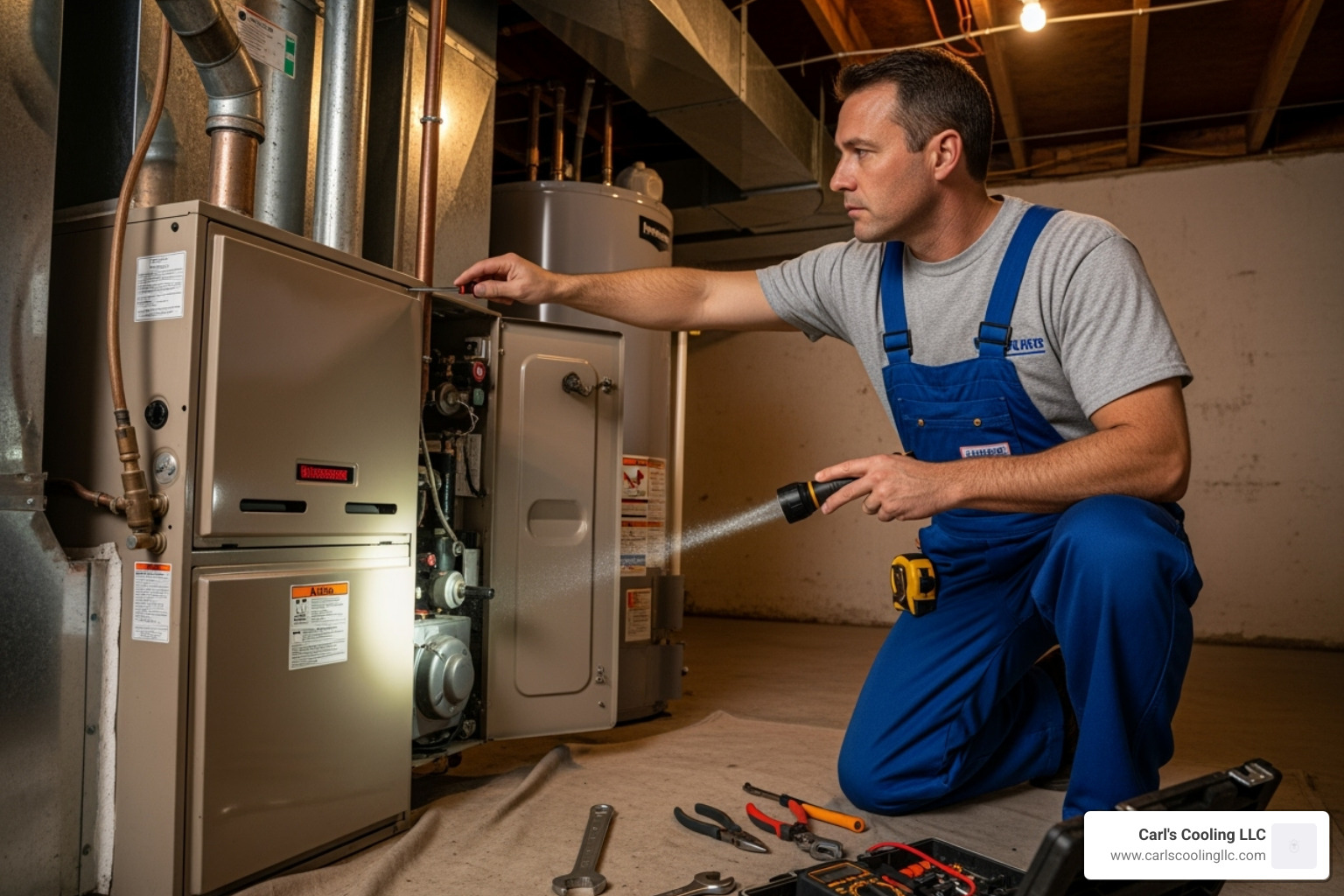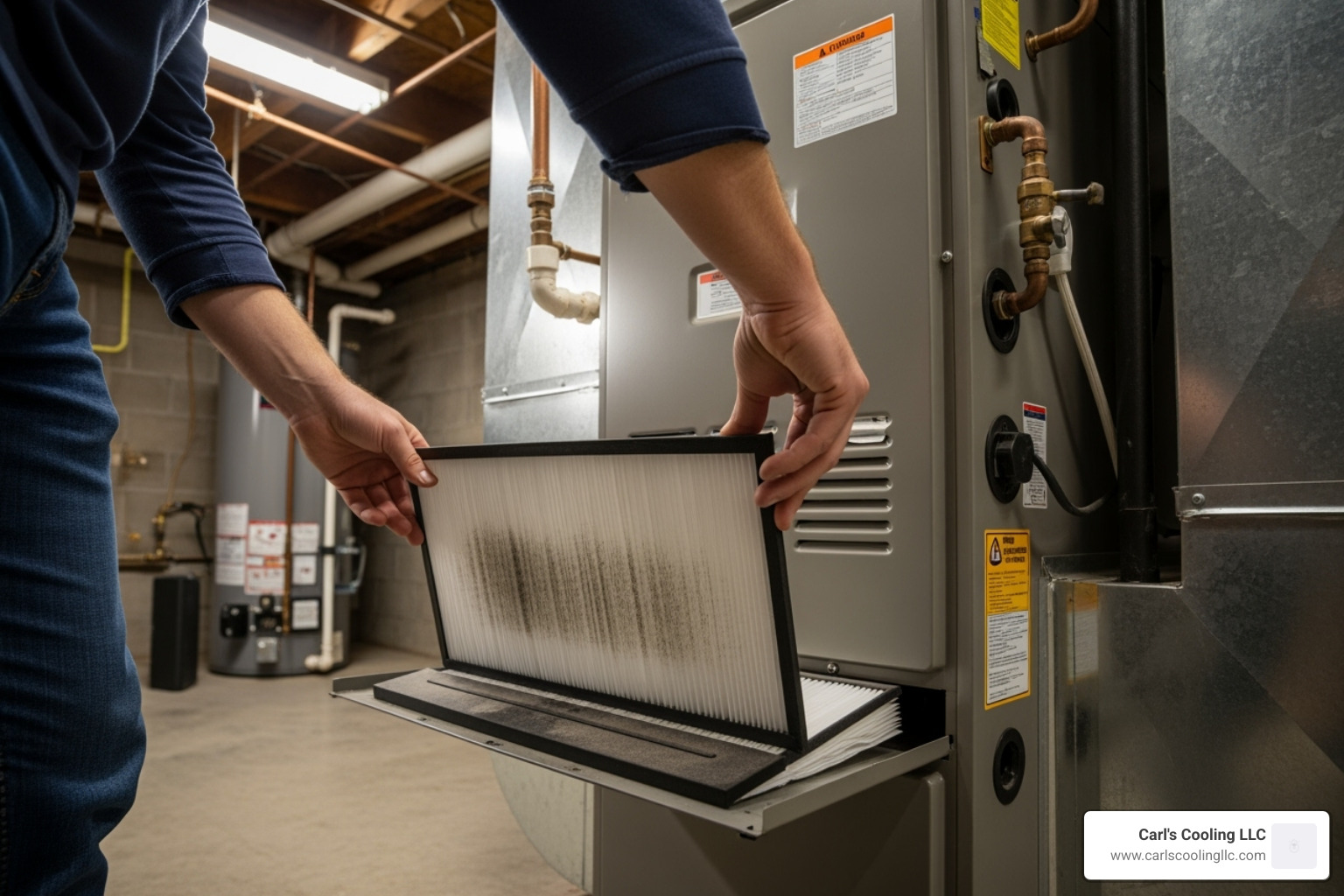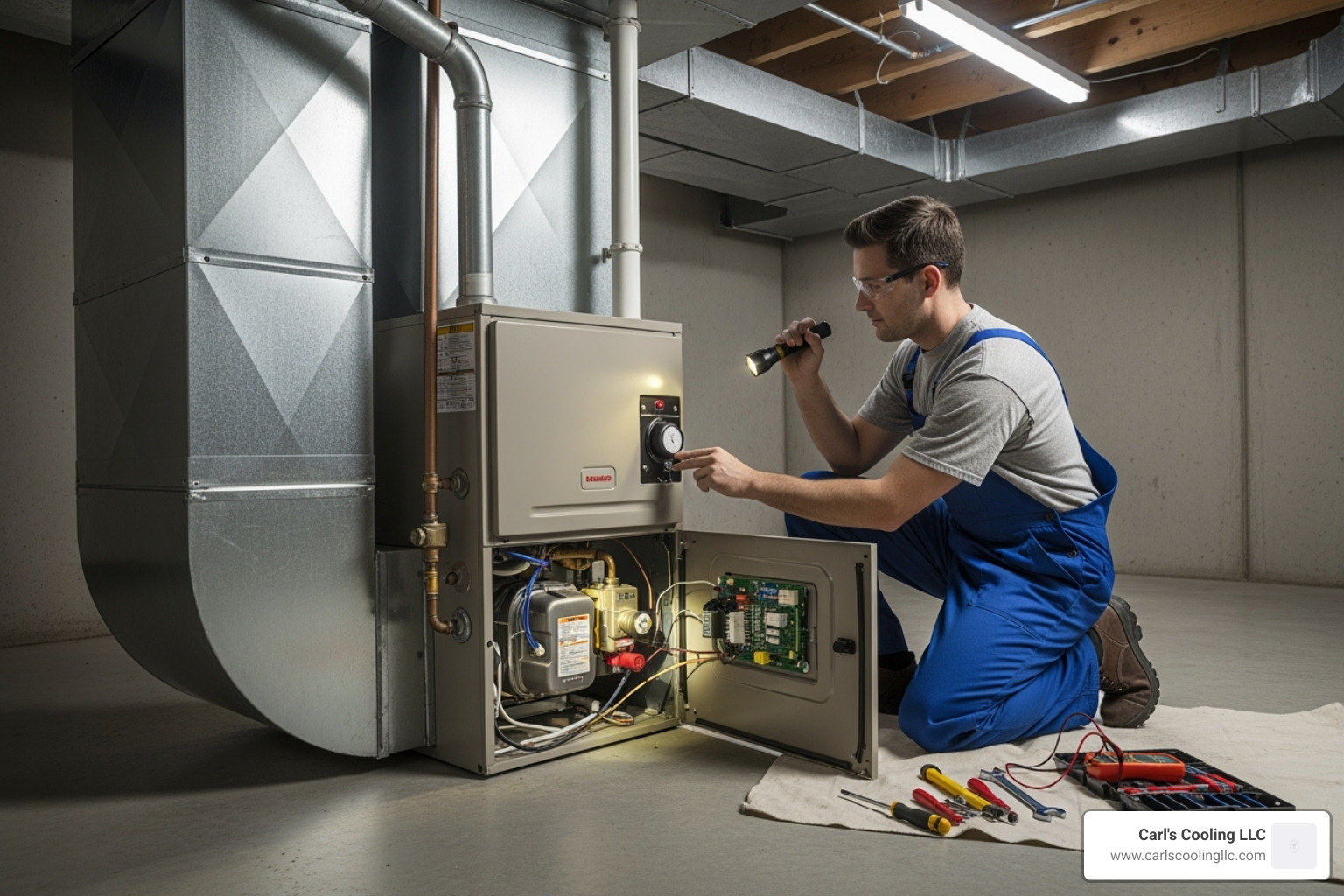Why Your Furnace Needs Annual Care to Keep You Safe and Comfortable
Annual furnace service is essential maintenance that keeps your heating system running safely, efficiently, and reliably throughout the winter months. Just like Richard Trethewey from This Old House says: "You wouldn't wait more than a year to service your car. The heat in your house is just as important."
Here's what annual furnace service provides:
- Safety protection - Prevents carbon monoxide leaks and gas hazards
- Energy savings - Maintains peak efficiency to lower your heating bills
- Longer lifespan - Extends your furnace life from 15-30 years with proper care
- Fewer breakdowns - Catches small problems before they become expensive emergencies
- Warranty protection - Keeps manufacturer warranties valid
Your furnace works hard all winter long, burning fuel and moving air through your entire home. Without regular maintenance, even the best heating systems start to break down. Dust builds up, parts wear out, and efficiency drops.
The research shows that regular maintenance can save you $100-$500 annually compared to emergency repairs. More importantly, a well-maintained furnace protects your family from dangerous carbon monoxide leaks and keeps everyone warm when temperatures drop.
Most homeowners schedule their annual service in early fall, before the first cold snap hits. This timing ensures your system is ready when you need it most - and helps you avoid those inconvenient holiday breakdowns when repair costs skyrocket.

Why Annual Maintenance is a Non-Negotiable for Your Home
Your furnace is like the hardworking friend who never complains - until one day it just stops working entirely. That's why annual furnace service isn't just a nice-to-have; it's absolutely essential for keeping your home safe, comfortable, and your wallet happy.
Think about it this way: you wouldn't drive your car for years without an oil change, right? Your furnace deserves the same attention. It works tirelessly through every cold snap, moving heated air throughout your entire home. Without regular care, even the best heating systems start to struggle under the pressure.
The truth is, skipping annual maintenance is like playing Russian roulette with your home's comfort and safety. Small problems that could be fixed easily during routine service turn into expensive emergencies that always seem to happen on the coldest day of the year.
The Critical Safety Benefits
Here's something that might surprise you: your furnace could be silently putting your family at risk right now, and you'd never know it.
Carbon monoxide leaks are the biggest concern. This invisible, odorless gas can seep into your home through a cracked heat exchanger - and trust us, you won't smell it coming. During annual service, our technicians carefully inspect every inch of the heat exchanger, looking for hairline cracks that could spell trouble.
But that's not all we check. We examine your flue system to make sure dangerous exhaust gases are properly venting outside where they belong. We test all gas connections for leaks (even though gas companies add that "rotten egg" smell, it's not foolproof). We also tighten electrical connections and look for worn components that could create fire hazards.
These safety checks give you something priceless: peace of mind. When our team finishes your annual service, you can sleep soundly knowing your heating system won't put your family in danger. A professional can test your furnace's efficiency and ensure it's operating safely.
Boosting Efficiency and Lowering Your Energy Bills
Nobody likes opening their heating bill in January and feeling their heart skip a beat. Here's the good news: a well-maintained furnace can dramatically reduce your energy consumption and keep those bills manageable.
Over time, your furnace collects dust and debris like a magnet. This buildup forces your system to work much harder to heat your home - imagine trying to breathe through a dirty mask all day. When key components like the blower motor and burners get clogged, your furnace has to run longer and use more fuel to reach the same temperature.
Annual furnace service cleans and calibrates these critical parts, helping your system achieve optimal performance. A clean, properly adjusted furnace heats your home more effectively while using less energy. This improved efficiency shows up as real savings on your monthly utility bills.
Plus, when your furnace isn't straining to do its job, it experiences less wear and tear. A forced-air furnace that receives regular care can easily last 15-30 years, compared to just 10-12 years for a neglected system.
Protecting Your Investment and Warranty
Let's be honest - replacing a furnace isn't exactly a fun way to spend your money. That's why protecting your current system makes so much financial sense.
Regular maintenance helps you avoid costly repairs by catching small issues before they become big problems. During annual service, we spot things like loose wires, slightly corroded parts, or worn components that could fail later. Fixing these minor issues during routine maintenance costs a fraction of what you'd pay for an emergency repair.
Most furnace manufacturers also require annual professional maintenance to keep your warranty valid. Skip these tune-ups, and you might find yourself paying out of pocket for repairs that should have been covered. Nobody wants that surprise!
Annual furnace service also prevents premature replacement by keeping your system running smoothly for its full expected lifespan. When you add up the costs, routine maintenance pays for itself many times over through avoided repairs, lower energy bills, and extended equipment life.
The bottom line? Annual maintenance gives you the ultimate peace of mind - knowing your furnace will keep your family warm and safe all winter long.
What to Expect During a Professional Annual Furnace Service
When you schedule annual furnace service with a professional, you're getting far more than a quick peek at your heating system. Think of it as a comprehensive health check-up for one of your home's most important appliances. We're talking about a thorough inspection and tune-up that touches every critical component of your furnace.

A professional tune-up goes way beyond anything you can safely tackle yourself. Your technician arrives with specialized tools and years of experience, ready to inspect, clean, and calibrate your entire system. They're hunting for potential problems before they turn into those dreaded middle-of-winter breakdowns that always seem to happen on the coldest night of the year.
The whole process is designed with three goals in mind: keeping your family safe, maximizing your furnace's efficiency, and extending its lifespan. It's like preventive medicine for your heating system.
The Professional's Maintenance Checklist
During a comprehensive annual furnace service, your technician will work through an extensive checklist that covers every important aspect of your system. The thermostat gets a thorough check to ensure it's talking to your furnace correctly and maintaining the temperatures you've set. Nobody wants a thermostat that thinks 68 degrees feels like 75!
Electrical connections receive careful attention because loose wires aren't just inefficient – they're downright dangerous. Your technician will inspect and tighten all the electrical components to prevent fire hazards and ensure reliable operation.
The gas pressure gets measured and adjusted to manufacturer specifications. Too much or too little gas pressure can cause poor performance or safety issues. Burners and flame sensors get a deep cleaning to ensure proper combustion. A dirty burner can create that concerning yellow flame instead of the clean blue flame you want to see.
Your blower motor undergoes a complete inspection since it's responsible for circulating all that warm air throughout your home. The technician checks for wear, proper operation, and that it's running quietly and efficiently.
Perhaps most critically, the heat exchanger gets examined for cracks or corrosion. This is a major safety check because any damage here could allow carbon monoxide to leak into your living space. It's one of those inspections that requires professional training and equipment to do properly.
For high-efficiency furnaces, condensate drains get cleared to prevent clogs that can shut down your system or cause water damage. The ignition system receives testing whether you have an electronic igniter or pilot light, ensuring reliable startup every time.
Moving parts get lubricated to reduce friction and wear, while safety controls undergo thorough testing. These safety mechanisms need to work perfectly to shut down your furnace if something goes wrong. Finally, the ventilation system gets inspected for blockages or leaks, and the entire system performance gets evaluated from start to finish.
Energy Star Maintenance Checklist
How to Choose a Qualified HVAC Contractor
Finding the right contractor for your annual furnace service is crucial. You're trusting them with equipment that keeps your family warm and safe, so you want to choose wisely.
Licensed and insured contractors should be at the top of your list. Always verify their credentials and insurance coverage. This protects you if something goes wrong during the service call.
Customer reviews tell the real story about a contractor's work. Check Google, Yelp, and other review platforms for consistent feedback about professionalism, reliability, and quality. Pay attention to how they handle any complaints or issues that come up.
A comprehensive maintenance checklist is non-negotiable. Any reputable contractor should have a detailed list that covers all the items we mentioned above. Don't be shy about asking to see their checklist before they start work.
Transparent pricing matters too. You should know what you're paying for upfront, without hidden fees or surprise charges popping up later. Good contractors believe in honest, straightforward pricing.
Finally, local experience makes a big difference. A contractor who knows your area understands the local climate challenges and will be available when you need follow-up service or emergency repairs. There's real value in working with someone who's invested in your community.
DIY Maintenance vs. Professional Service: What You Can (and Can't) Do
We absolutely love seeing homeowners take pride in caring for their homes! There's definitely a place for DIY maintenance when it comes to your heating system. But here's the thing – knowing where to draw the line between what you can handle and what needs a professional touch is crucial for your safety and your furnace's wellbeing.

Think of it this way: you might change your car's oil, but you probably wouldn't attempt to rebuild the engine. The same principle applies to your furnace. While your DIY efforts are valuable and can definitely help your system run better between professional visits, they're never a replacement for your annual furnace service.
Professional HVAC technicians bring years of training, specialized diagnostic equipment, and the expertise to safely handle gas lines and electrical components. They can spot potential problems that aren't visible to the untrained eye and make precise adjustments that keep your system running efficiently and safely.
DIY Tasks to Complement Your Annual Furnace Service
Let's talk about what you can do to keep your furnace happy between professional visits. Changing your air filter is probably the most important task you can handle yourself. A clean filter keeps your system breathing easy and running efficiently. Most filters need replacing every 1-3 months, but if you have pets or family members with allergies, you might need to change them more frequently.
Cleaning your vents and registers is another simple but effective task. Dust and debris can block airflow, making your furnace work harder than necessary. A quick vacuum around supply and return vents helps maintain good circulation throughout your home.
Don't forget about your thermostat batteries – it's amazing how often a simple dead battery gets mistaken for a major furnace problem! Keeping the area around your furnace clear is equally important. Your heating system needs space to breathe, so avoid storing boxes, holiday decorations, or cleaning supplies nearby.
You can also be your furnace's early warning system by listening for unusual sounds like banging, grinding, or squealing. These noises often signal that something needs professional attention. For gas furnaces, checking the pilot light color is something you can safely observe – it should burn a steady blue with just a small yellow tip.
Now, here's where we draw the line. Gas pressure checks require specialized gauges and training to perform safely. Internal electrical work should always be left to professionals who understand voltage requirements and safety protocols. Deep cleaning of internal components like burners, flame sensors, and blower motors requires disassembly and expertise that most homeowners don't have.
The heat exchanger inspection is absolutely critical for safety – cracks in this component can lead to dangerous carbon monoxide leaks, and only trained technicians have the tools and knowledge to properly evaluate it. Combustion analysis and testing safety controls also require professional-grade equipment and expertise.
Warning Signs That Your Furnace Needs a Tune-Up
Your furnace has its own way of asking for help – you just need to know how to listen. Unusual noises are often the first cry for attention. While your furnace isn't going to be completely silent, new sounds like banging, rattling, whining, or grinding usually mean a component is wearing out or something has come loose.
Strange smells deserve immediate attention. A light dusty smell when you first fire up your system for the season is normal, but persistent odors are red flags. That rotten egg smell? That's a potential gas leak. Burning plastic or metallic odors could indicate electrical problems or overheating components.
Keep an eye on your energy bills too. If your heating costs are creeping up without any major weather changes or thermostat adjustments, your furnace is likely losing efficiency and working overtime to keep you comfortable.
Uneven heating throughout your home is another telltale sign. If your living room feels like a sauna while your bedroom stays chilly, your system might be struggling with airflow issues or distribution problems.
Short cycling – when your furnace turns on and off frequently in short bursts – often indicates the system is overheating or having trouble maintaining proper temperatures. This pattern is hard on your equipment and wastes energy.
For older furnaces with pilot lights, pay attention to the flame color. A yellow or flickering pilot light instead of a steady blue flame can indicate incomplete combustion, which is a serious safety concern that requires immediate professional attention.
Don't ignore these warning signs! Addressing them promptly with professional service can prevent small issues from becoming major headaches that leave you without heat on the coldest day of the year.
Understanding the Costs and Long-Term Savings
Let's talk dollars and cents for a moment. We know that when you're already juggling household expenses, adding another annual service might make your wallet feel a little lighter. But here's the thing about annual furnace service - it's not really an expense at all. It's more like putting money in a savings account that pays you back all winter long.
Think of it this way: you can either pay a little now for maintenance, or pay a lot later for emergency repairs. And trust us, furnaces have a knack for breaking down at the worst possible moments - like during that arctic blast when repair technicians are booked solid and charging premium rates.
The math is pretty straightforward when you break it down. Emergency repairs don't just cost more because of the parts and labor - you're often paying rush fees, weekend rates, and sometimes even having to pay for temporary heating while you wait for parts. Meanwhile, that same problem could have been caught and fixed during a routine tune-up for a fraction of the cost.
The Financial Case for Annual Furnace Service
Here's where the numbers get interesting. A typical furnace tune-up might seem like an upfront cost, but it's actually working behind the scenes to save you money in multiple ways. Some homeowners choose maintenance plans that cover their heating and cooling needs year-round, often with added perks like repair discounts.
But the real savings show up in places you might not expect. A well-maintained furnace uses less energy - sometimes significantly less. That efficiency boost translates directly to lower utility bills every month throughout the heating season. Over time, those monthly savings can easily cover the cost of your annual service.
Then there's the big-ticket item prevention. Research shows that homeowners who invest in regular maintenance typically save $100 to $500 annually compared to those who skip it and end up facing emergency repairs. A cracked heat exchanger or failed blower motor can quickly turn into a budget-busting repair bill, not to mention the discomfort of being without heat.
The beauty of annual furnace service is that it catches these expensive problems when they're still small, manageable issues. It's like fixing a small leak in your roof before it becomes a ceiling collapse - the earlier you catch it, the less it costs to fix.
Plus, let's not forget about extending your furnace's lifespan. Every year of additional life you squeeze out of your system is money you're not spending on a premature replacement. When you consider that a new furnace is a major investment, those extra years of reliable service really add up.
Frequently Asked Questions about Furnace Maintenance
Over the years, we've heard just about every question you can imagine about furnace care. Some homeowners wonder if they're being too cautious, while others worry they've been too lax. The good news? There are no silly questions when it comes to keeping your family safe and comfortable!
Let's tackle the most common concerns we hear from homeowners like you.
How often should a furnace really be serviced?
The industry standard is once per year, ideally in the fall before the heating season begins, to ensure safety and efficiency. Think of it like your annual physical at the doctor – even if you feel fine, that yearly check-up catches things before they become serious problems.
We always recommend scheduling your annual furnace service in early autumn, typically September or October. This timing is perfect because you're getting ahead of the rush, and your system gets a clean bill of health before you really need it. Plus, if we do find something that needs attention, you have time to address it before the first cold snap hits.
If you live in an area with particularly harsh winters or your furnace runs almost constantly, some homeowners choose to have their system checked twice a year. But for most folks, that yearly tune-up is exactly what your furnace needs to stay happy and healthy.
Can I skip a year of furnace maintenance if it's running fine?
Skipping maintenance is not recommended as it can void warranties, lead to lower efficiency, and allow minor issues to become major, costly repairs. We know it's tempting to think, "If it's not broken, don't fix it!" But here's the thing – your furnace might seem fine on the surface while quietly developing problems underneath.
It's a lot like that old saying about the frog in boiling water. Your furnace's efficiency might be slowly declining, your energy bills gradually creeping up, and small components wearing down – but these changes happen so gradually that you don't notice until something major goes wrong.
Skipping even one year can void your manufacturer's warranty, which means if something expensive breaks, you're on your own for the repair bill. That yearly service isn't just about keeping your furnace running; it's about protecting your investment and keeping your family safe.
What happens if I never service my furnace?
A neglected furnace will have a shorter lifespan (10-12 years vs. 15-20+), run less efficiently, be more prone to sudden breakdowns, and pose potential safety risks like carbon monoxide leaks. It's honestly a bit like never changing the oil in your car – things might seem okay for a while, but eventually, you're heading for trouble.
Without regular cleaning, dust and debris build up on critical components, forcing your system to work harder and consume more energy. Your monthly heating bills start climbing, but the changes are gradual enough that you might not connect the dots right away.
The real concern, though, is safety. A neglected furnace can develop carbon monoxide leaks from a cracked heat exchanger, gas leaks from loose connections, or electrical hazards from corroded wiring. These aren't just inconveniences – they're genuine safety risks for your family.
We've seen furnaces that could have lasted 20 years give up the ghost at 10 or 12 because they never got the care they needed. Don't let that be your story! Regular maintenance keeps your furnace running safely, efficiently, and for as long as possible.
Keep Your Home Warm and Safe This Winter
Winter comfort shouldn't be a gamble. Throughout this guide, we've shown you how annual furnace service transforms from a simple maintenance task into your home's safety net. It's the difference between curling up confidently by the fireplace and worrying whether your heating system will make it through another cold snap.
Think about it this way: your furnace is like a trusted friend who works tirelessly behind the scenes, keeping your family comfortable when temperatures drop. Just like any good friendship, it needs attention and care to thrive. When you invest in regular maintenance, you're not just buying a service - you're buying peace of mind.

The benefits we've discussed aren't just theory - they're real advantages that impact your daily life. Safety protection means sleeping soundly without worrying about carbon monoxide leaks. Energy savings show up as lower utility bills month after month. Extended equipment life means avoiding those heart-stopping moments when your furnace decides to quit on the coldest night of the year.
Being proactive instead of reactive is always the smarter choice. Emergency repairs don't just cost more money - they happen at the worst possible times. Holiday weekends, family gatherings, or during that brutal cold snap when every HVAC company in town is swamped with calls.
At Carl's Cooling LLC, we understand that your family's comfort and safety aren't negotiable. Our experienced technicians bring the expertise and care your heating system deserves. We're not just maintaining equipment - we're protecting what matters most to you.
Don't wait for warning signs or worry about "what if." Take control of your home's comfort today and give yourself the gift of worry-free warmth all winter long.






